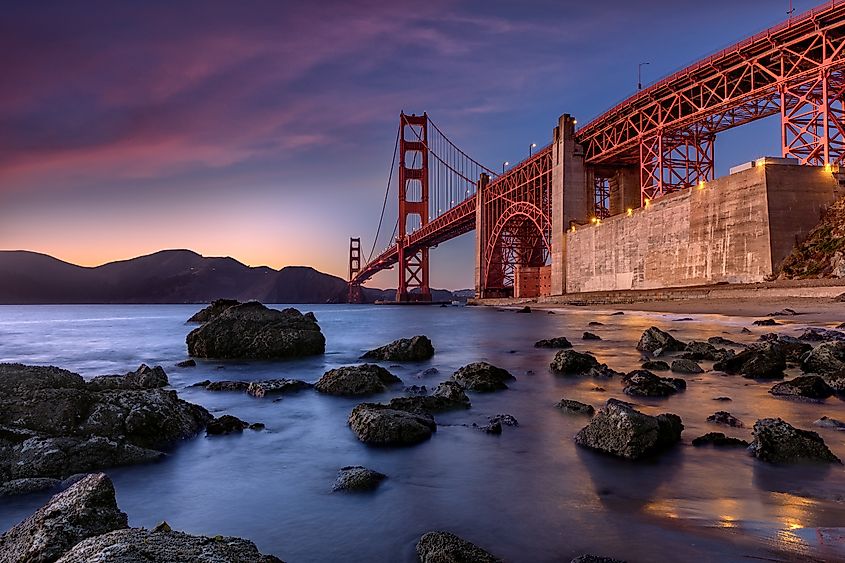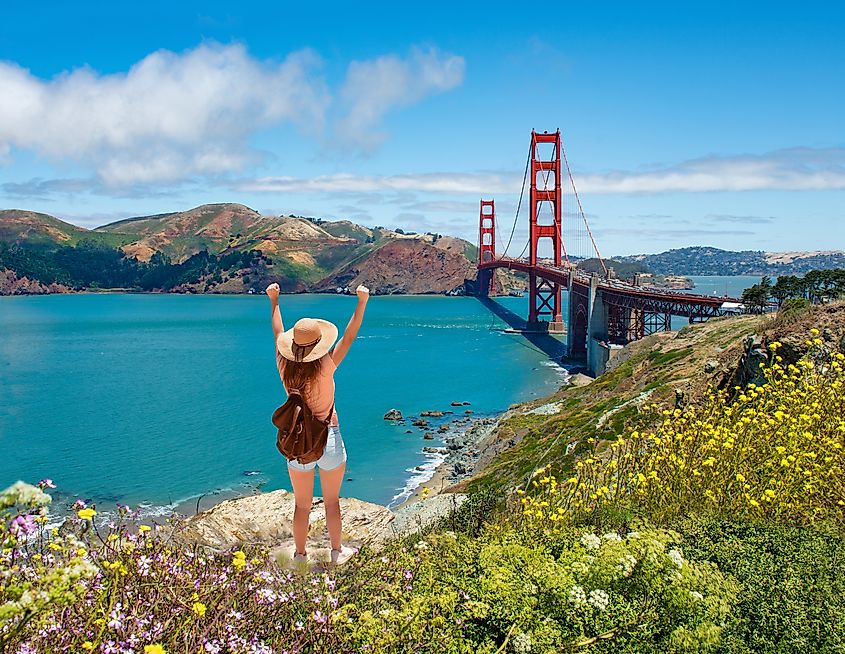
The Golden Gate Bridge
Nestled between the emerald waters of the San Francisco Bay and the rugged coastline of the Pacific Ocean, the Golden Gate Bridge stands as an enduring symbol of architectural brilliance and American ingenuity. This world-renowned landmark is more than just a bridge; it’s a testament to human ambition and a beacon for travelers from around the globe.
Whether you're planning a visit or simply dreaming of a future trip, here’s everything you need to know to make the most of your Golden Gate Bridge experience.
The Birth of a Giant

Early stage of Golden Gate Bridge construction, July 16, 1934.
The story of the Golden Gate Bridge begins in the 1930s, a time when the world was grappling with the Great Depression. The visionary behind this engineering marvel was Joseph Strauss, an engineer with an audacious dream of bridging the strait that separates San Francisco from Marin County. His ambitious project faced numerous challenges, from fierce winds to treacherous waters, and was met with skepticism from critics. However, after four years of construction, the bridge was finally completed in 1937, becoming the longest and tallest suspension bridge in the world at that time.
Design and Engineering Feats

Golden Gate Bridge during sunset new San Fransisco.
What makes the Golden Gate Bridge so striking is its Art Deco design, characterized by its sleek lines and elegant towers. The bridge’s striking International Orange color, chosen to enhance visibility in San Francisco’s often foggy weather, is a bold choice that has become synonymous with the bridge itself. The color was selected by consulting architect Irving Morrow, who believed it would contrast beautifully with the natural surroundings and improve safety.
From an engineering perspective, the Golden Gate Bridge was a marvel. Spanning 1.7 miles in length, with towers that rise 746 feet above the water, it was a feat of its era. The bridge’s construction required over 80,000 miles of steel cable and more than 600,000 rivets. Even more impressive is the fact that the bridge has withstood numerous earthquakes and harsh weather conditions, a testament to its robust design and the foresight of its engineers.
You May Also Like: 10 Of The Longest Bridges In The United States
Experience the Bridge

There are countless ways to experience the Golden Gate Bridge, each offering a unique perspective. Here are some must-do activities for visitors:
-
Walk or Bike Across the Bridge: For those looking to fully immerse themselves in the experience, walking or biking across the bridge is an exhilarating way to appreciate its scale and panoramic views. The bridge’s pedestrian walkways are open daily, allowing you to take in the stunning vistas of San Francisco, the bay, and the Pacific Ocean. If you’re biking, you’ll find dedicated bike lanes that make the journey safe and enjoyable.
-
Visit the Vista Points: Both the north and south ends of the bridge feature scenic viewpoints. The Golden Gate Bridge Welcome Center on the south side provides historical exhibits and a perfect vantage point for photos. On the north side, the Marin Headlands offer breathtaking views of the bridge from a distance, where you can capture stunning photographs with the rugged coastline as a backdrop.
-
Explore the Fort Point National Historic Site: Located just beneath the southern end of the bridge, Fort Point is a Civil War-era fortress that offers a unique perspective on the bridge’s construction. The fort’s strategic position provides a dramatic view of the bridge’s underside and a glimpse into the history of the area.
-
Take a Bay Cruise: For a different vantage point, consider embarking on a bay cruise. Several tour operators offer boat tours that navigate under the bridge, providing a spectacular view from the water. These cruises often include informative commentary about the bridge’s history and significance.
-
Photography Tips: To capture the bridge in all its glory, try visiting at sunrise or sunset when the lighting is soft and the colors are vibrant. The bridge is particularly photogenic when shrouded in fog, which often rolls in from the ocean and creates a mystical atmosphere.
Cultural Significance

Buildings and palm trees along path with people walking toward Golden Gate Bridge.
The Golden Gate Bridge has not only become an engineering icon but also a cultural one. It has appeared in countless films, TV shows, and advertisements, symbolizing both the beauty and innovation of San Francisco. Its image is instantly recognizable, and it evokes a sense of wonder and achievement. The bridge has also been a backdrop for significant events, including the annual Bridge to Bridge Run and various cultural festivals.
Environmental and Safety Considerations

While the Golden Gate Bridge is a marvel of human achievement, it’s important to be mindful of its environmental impact and safety measures. The bridge is a vital transportation link, but it’s also a protected site with strict regulations. For instance, fishing and swimming near the bridge are prohibited due to safety concerns and to preserve the surrounding marine environment.
Conclusion
A visit to the Golden Gate Bridge is a journey into the heart of San Francisco’s spirit and resilience. From its awe-inspiring design to its rich history and cultural significance, the bridge is a testament to human creativity and perseverance. Whether you’re strolling across its span, capturing its majesty through your camera lens, or simply admiring it from afar, the Golden Gate Bridge promises an unforgettable experience. As you plan your adventure, remember that this iconic structure isn’t just a bridge—it’s a gateway to unforgettable memories and a symbol of the boundless possibilities of human endeavor.